AGRONOMIC UPDATE – July 31, 2023….what a difference a month can make….

Topics:
– Growing Degree Day Update/Forecast Maps
– What’s going on in my fields?…..Corn Development, ET rates, Disease, etc.
– Insect Update
– Soybean Development
TEMPERATURES & GDU ACCUMULATION:
As of July 30th, we have accumulated approximately the following for Growing Degree Units in 2023:
Planting Date GDD’s2022 Average GDD Departure from average
April 17 1878 1855 + 23 (+ 1 day)
April 26 1834 1796 +38 (+1.5 days)
May 9 1703 1687 +16 (+ .5 days)
We see from the above numbers that we continue to track normal for GDU accumulation since the last update on July 12th. In fact, we are tracking very similar to 2022. The next two week forecast, however, is for cooler temps….
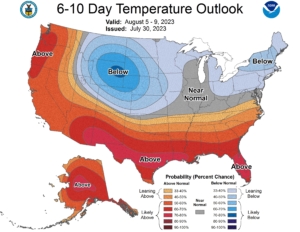
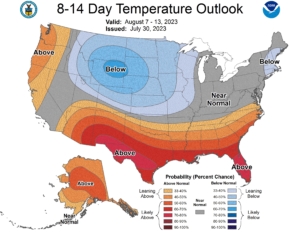
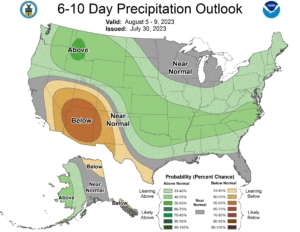
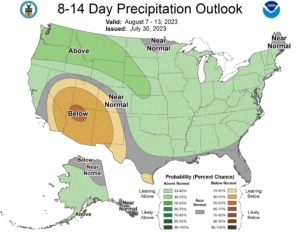
These maps are the 6-10 and 8-14 day forecasts for temperature and precipitation. Our area is predicted to be below normal for temperatures and slightly above normal precipitation. We continue to receive much needed rainfall, however, crop development will slow down over the next two weeks if this forecast is correct.
WHAT’S GOING ON IN MY FIELD?…..Corn Development, Disease, Crop Water Use..
Most of the corn crop is in the late-R2 (Blister Kernel) to early-R3 (Milk) to R3 (Milk) stage. The heat last week really pushed the crop along. The late planted fields (ie. after rye, etc.), are just starting to tassel.
- Pollination overall seems to be good so far. Finding the usual checkerboard pattern on the butt of the ear in some fields, but overall looks good.
- Plant height this year seems to be normal….taller than last year, but not as tall as two years ago.
- At R1, potassium uptake is essentially complete, and nitrogen and phosphorous uptake are rapid. Last round of N should be going on this week.
- Blister Kernel occurs approx. 10-14 days after Silking. Starch has begun to accumulate in the watery endosperm and the kernels are beginning a period of rapid, steady, dry matter accumulation that will continue until physiological maturity in approx. 50-60 days after silking.
- At Blister Kernel, maximum ear length is achieved. Although not as severe as at Silking, stress over the next two weeks can still have a profound effect on yield through kernel abortion, which is why this last rain was such a Godsend….
- Kernel abortion from stress can occur through the Milk stage(18-22 days after silking), however when the plant reaches Dough, kernel abortion will no longer take place, and any yield reduction from then on out will be from lower test weight. We are currently in the ‘tip-back’ stage of growth and it will be a week or so to see how well the plant will ‘hold’ kernels per row. Temperature and sunlight will play a role here….
- As far as sunlight is concerned, we are currently running about 12% percent below normal over the last 14 days (last year at this time we were 10% below normal), or from V16-Early Milk. Sunlight, of course, is now a much bigger yield factor, since we are now beginning the crucial grain fill period. As such, how much sunlight and when it occurs during the grain-fill period, will play a role in overall yield and late-season plant health. Lack of sunlight early in the grain fill period (i.e. right now) can increase potential for the ear to tip back.
- Extra stress will occur if sunlight is reduced and temps (especially nighttime) are higher than average (which is not predicted). This stress occurs because, since temps are high (especially nighttime temps), the energy demand on the plant is higher than average; couple this with reduced photosynthesis, and this leads to greater energy in the plant just going to maintain itself and not to filling the ear. It is an axiom in corn production that when you have to run your air conditioner at night, it is not good corn growing weather.
- Relative Humidity over the past two weeks has been 9% above normal, with a daily average of 74% RH during this time frame. While this leads to decreased ET rates; it increases the potential for more disease in corn and soybeans.
- ET rates for the past 15 days have been averaging .27 inch/day, which is normal. This is .04 inches/day below 2022. Total ET usage over the past 14 days has been 3.83″. The rains, indeed, were a blessing!! The forecasted cooler temps will keep overall ET rates normal to slightly below normal….keep in mind corn at Blister Kernel is average of .28/inch per day and Milk stage is .25″/day in normal weather. Soybeans are now at peak usage at R3-R4 stage….over .30 inch/day normal. Maintaining an adequate soil moisture profile will be key over the next three weeks or so. As you think about irrigation needs over the next two weeks, keep temperatures and relative humidity in mind as we move forward to see what actually occurs to help reduce potential water stress or potential over watering. If dew points are low (dry mornings), that means relative humidity is low, and ET rates will stay up higher than normal. On the flip side, if heat indices are high in which a 95 degree actual temperature feels like 110 degrees (which is what we experienced last week), then relative humidity is high and ET rates will be average to below average. Forecasts for this week are calling for normal temperatures and higher humidity….
- So far corn leaf diseases continue to be on the low side, however, we expect that to change over the next few weeks if the above forecasts are true. Seeing mainly Bacterial Leaf Streak, which has increased quite a bit over the last two weeks. Some fields showing first grey leaf spot as well, and we have seen a few Northern Corn Leaf Blight lesions around. Starting to see some Goss’s Wilt show up in those fields which had the worst hail from a few weeks ago. Crop Focus – Northern Corn Leaf Blight
- Fungicide application should be on, or going on now, and into next week on the later planted fields. You want to protect the plant when it is working the hardest, which is silking through milk stage (which is NOW!). Reminder, a fungicide will not help control Goss’s Wilt or Bacterial leaf streak.
SOYBEAN UPDATE
- Much of the crop is in the late-R3(pod set) to R4(full pod) stage of growth. Some fields are starting the R5 (Beg. Seed) stage. This is ahead of normal in my opinion. The heat has also pushed the soybeans along. Overall plant height will be tall…the beans have really taken off as of late. Keep this in mind when irrigating….
- Peak water use, nutrient demand, and overall energy demand in the plant occurs at R3 and into R4 stage….i.e. right now and into the next few weeks!
- ET rates in soybeans reach peak at R3 into R4 stage (.30+ in/day) and will continue to stay high through R6(full seed). See comments above on corn ET rates, as the same applies for soybeans. One will need to be careful not to water constantly to help reduce disease potential (see below on white mold) due to a constantly ‘wet canopy’. If White Mold becomes a problem, it will be best to water at night and leave off during the day so the canopy has some chance to dry out. In heavy soils, when irrigation is needed, we recommend running a heavy irrigation amount (.80 to inch+) and then leaving it sit for a while.
- We are seeing first signs of White Mold in many area fields, more so than we have seen in the past few years. Weather conditions of the past few weeks have been conducive for development of this disease. If the above forecasts hold true, expect a much heavier outbreak of White Mold this year versus past few years. Any 2nd treatments for White Mold need to go on at R3 and should really be on by now. See the attached link for White Mold management. Managing White Mold in Soybeans We recommend Aproach or Delaro fungicide for any white mold control. High temps and dry mornings will slow the disease down.
- Sudden Death Syndrome – also seeing our first plants with SDS. This disease is showing up in the usual spots….low areas, compacted, poor drainage….
- Enlist E3 Soybeans – Below are some pictures of Enlist soybean fields in the area. After some cupping from Atmospheric Dicamba, many Enlist fields are looking very strong….


- Enlist E3 soybean field video…
- Enlist E3 Weed control system also looks good so far…..
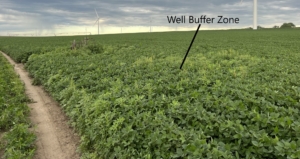 Photo shows excellent control versus the buffer zone around a well-head….
Photo shows excellent control versus the buffer zone around a well-head….
INSECT UPDATE – Corn & Soybeans
- Keep scouting for Western Bean Cutworm larvae. Moth flight has been lower overall versus last few years and infestation levels have been on the low side, just enough to warrant treatments in most sandy fields. From GDU data, we expect that the flight is 80-90%% complete. Any potential treatments should be on, or going on ASAP, as we are now finding small larvae on the ear tips, on top of the silks. Any delay in treating, and they will be too far into the ear tip for control. Keep in mind your June planted corn fields….
- With cooler and wetter conditions, Grasshopper numbers have decreased dramatically….
- We are just starting to see the first 2nd brood ECB moths start to fly. Keep this insect in mind on your conventional and popcorn acres over the next two weeks.
- Overall insect pressure in soybeans has been very light. Very little defoliation going on yet. Begin scouting for Bean Leaf Beetles as they will begin feeding on developing pods over the next few weeks. So far we are not finding any Soybean Aphids. If you have made an insecticide application already, or are going to, this should give you season long control unless a severe outbreak of one of these insects occurs.
- Dectes Stem Borer – be on the lookout for this insect starting now and into harvest. We saw quite a bit of this in our area last year, especially south and east of Elgin. We have seen the adult beetles in some area fields over the past few weeks. Watch field edges first and let us know if you are seeing wilted and dying plants as they move in from the grassy edges. If you see this, keep these fields in mind for earlier harvest. Dectes Stem Borer in Soybeans
- Seeing a few small colonies of Corn Leaf Aphids(dark green aphid) in area corn fields. They tend to proliferate under cooler and damper conditions, so we may see their numbers increase in the area. They are not an economic concern, but you may begin to notice them as you walk through your fields.
- So far not seeing much for Spider Mite colonies. However, if temperatures turn out as forecasted (cooler temps and higher relative humidity), infestation levels should be on the light side. Keep an eye out for this insect over the next month or so.
Please mark your calendar for the Pioneer Annual Customer Appreciation Supper which is set for Sunday, August 20th. Invite will be coming out soon! The Pioneer Plot Tour will be, Wednesday, August 30th.
Please contact us with any questions or comments you may have! Thank you for your business!!
Starman Seed Service, Inc.

